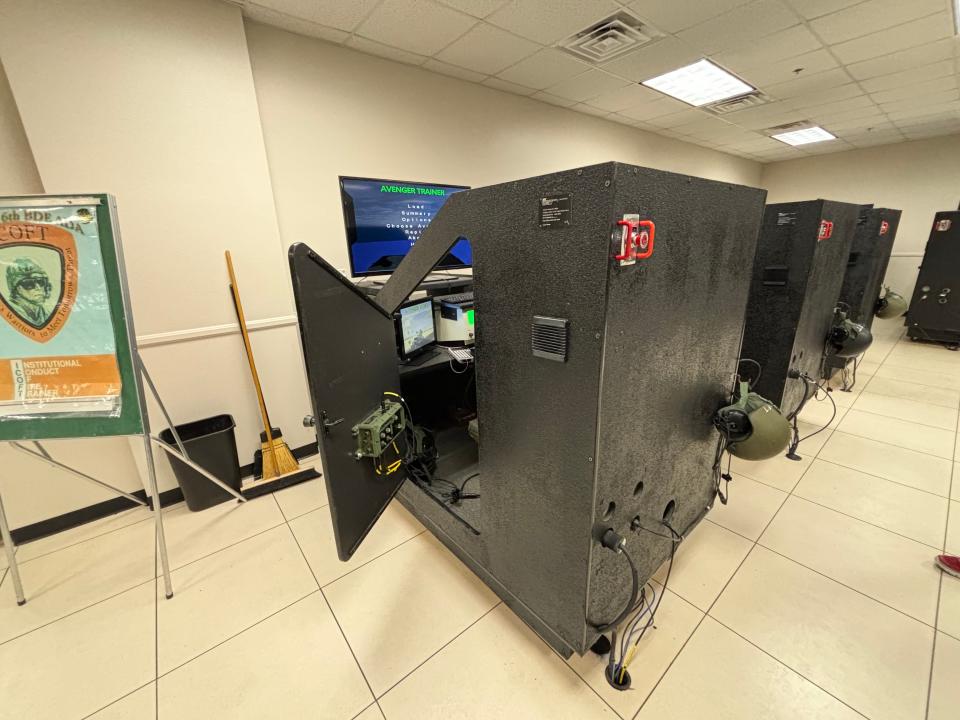Inside the US Army's 'Stinger Dome,' scoring a kill with the weapons Ukraine got to shoot down Russian helicopters is harder than it looks
Business Insider recently traveled to Fort Sill, home to the US Army's Air Defense Artillery School.
Our reporter got to train on two short-range air-defense systems: the Avenger and the Stinger.
Taking out simulated enemy helicopters proved to be surprisingly difficult.
The US military has air and missile defenses that can shoot down threats from beyond our atmosphere down to just a few feet off the ground.
I recently tried my hand at eliminating hostile aircraft with two short-range systems — the Avenger and Stinger — during a visit earlier this month to Fort Sill, Oklahoma, home to the US Army's Air Defense Artillery School where soldiers train on air- and missile-defense systems.
My training on the Avenger and Stinger involved practicing with two different types of simulators, and while they felt pretty realistic, I found one to be a lot more immersive than the other. They were also both a lot more difficult than they looked at first glance. In fact, it felt a bit like playing a video game on expert mode.
The US military has used the short-range Avenger for decades to provide valuable protection on the go. It's essentially a High Mobility Multipurpose Wheeled Vehicle, or Humvee, equipped with a .50 caliber machine gun and Stinger missiles.

The vehicle, which is outfitted with a turret that can rotate a full 360 degrees, can engage relatively low-flying targets like cruise missiles, drones, fixed-wing aircraft, and helicopters from both stationary and moving positions.
To train on how to engage enemy forces with the Avenger, soldiers at Fort Sill practice with a simulator called the Institutional Conduct of Fire Trainer, or ICOFT, which provides computer-generated battlefield scenarios where short-range air defense would be needed.

This activity takes place in room that has more than a dozen little wall-in cubicles, each with their own simulator intended to mimic the Avenger's fire control system.
I picked my cubicle and sat down, ready to tackle some enemy aircraft, and an instructor selected my course; I was tasked with protecting a convoy from aerial threats in Iraq.
The first thing I did was scan the sky on my screen for aircraft. Once I spotted one, I identified whether it was a friend or foe, and after confirming it was hostile, I fired off Stinger missiles and the machine gun to try and knock it out of the sky.
I was unsuccessful. I found it challenging to maneuver the control stick and quickly reorient by point of view to get the aircraft in range.


After practicing on the Avenger, it was time to move to the Stinger.
The FIM-92 Stinger is a well-known American man-portable air-defense system, or MANPADS, that uses infrared-guided missiles to engage ground-attack aircraft and drones from several miles out.
Stinger missiles have seen combat in a whole slew of wars dating back to the 1980s and were one of the first weapons that the US sent to Ukraine after Russia launched a full-scale invasion of its neighbor in February 2022, alongside anti-tank weapons like the Javelin.

At Fort Sill, training on the Stinger includes a trip over to the Improved Moving Target Simulator, or IMTS. This facility is more casually referred to as the "Stinger Dome," and is essentially like stepping into a virtual reality scene — just without a headset.
An operator is tasked with standing in the middle of the dome and using a Stinger to fire on computer-generated enemy aircraft that are projected onto the walls inside the dome.

The Stinger is a shoulder-fired weapon, and I was surprised at first by how heavy it felt (it only weighs about 36 pounds, but it kind of catches you off guard if you aren't expecting it). It is not easy to move around quickly with it to change the direction you're pointing the weapon.
During this simulation, I was once again tasked with taking out enemy helicopters. An instructor helped me find them in the simulator, and the next thing I had to do was identify whether an aircraft was a friend or foe.


After making this determination and locking on to a target, I engaged the helicopter by squeezing the Stinger's trigger. I recorded several misses, although I did manage to shoot down one of the helicopters. I penciled that in for one in the win column.
I found it difficult to continuously pivot my body and keep the Stinger pointed at the helicopters as they traversed the screen, which made it tough to lock on to a target. Because of this, the helicopters either disappeared before I could get my shot off, or I just missed.
Reflecting on my brief training, I found the Avenger to feel a lot more like playing a video game — albeit an extremely sophisticated one — than the Stinger Dome, where I felt like I was actually engaging enemy forces in the desert.
Both of the simulations were equally difficult, though, and I walked away knowing that I probably wouldn't make a very good air defender and with a new-found appreciation for anyone that has to do this for real.
Read the original article on Business Insider

 Yahoo News
Yahoo News 
